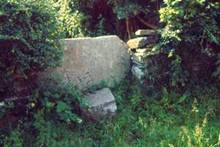Held at: | private collection |
Reference: | gc |
Source: | observation and research |
Title: | Stone Slab Stiles |
Place name: | Ewyas Lacy |
Date: | 1700s 1800s |
Description:
|
|
| A typical Stone Stile of Ewyas Lacy |
One of the pleasures of travelling about in various parts of the British countryside is to observe local variations in the traditional design and construction of a whole range of commonplace vernacular functional items. Such a country item with a wide range of constructions is the common stile. The essential function of a stile is to allow the passage of a person on foot whilst preventing that of animals or vehicles. This common need has been met by many local variations.
In the southern counties wooden stiles of one sort or another were dominant; there are also many iron types - often associated with the railways. In northern counties 'snickets' in stone walls are the rule. There are many stiles with ingenious mechanisms where intelligence and dexterity are used to discriminate in allowing passage of man and prevent that of stock. No stiles are perhaps simpler than the variant which in past years was adopted in our own area. Here as one travels about one becomes familiar with the use of a plain slab of stone, two to three feet high, two to three inches thick set into a hedgerow forming a stile, allowing people to stride over with moderate ease.
|
|
|
|
The form of construction using as it does, a heavy unwieldy slab required a suitable stone quarry being actively worked within a reasonable distance. Such quarries were common in all our local parishes before this century. It is the passing of these quarries, and also changes in circumstances, which prevented this particular form of stile construction continuing.
The construction of a stone slab stile is remaining testimony to the moral, social and probably customary obligation that was on our forefathers when enclosing parts of open common to preserve the rights of way that had already been established.
Each stile would have been built at the time that its host hedgerow was planted. They would not have been inserted into existing hedges. They are silent evidence that a right of way across the earlier open common land had been established long before that particular field had been enclosed to be taken into a neighbouring expanding farm. We have from Court Rolls, evidence that many of these particular enclosures date back to the 16th century and possibly before.
These stone stiles are not found in the boundary hedges of the original small freehold farm holdings; these were generally of an ‘island’ nature and any local right of way skirted around them rather than going directly through. The stiles are also not to be found in the Upper and Lower Maescoed areas; here the enclosure pattern was different with each of the closely packed small holdings requiring lane access for cattle and sheep movements. By the 1820’s this form of stile had gone out of fashion. The enclosure of the Middle Maescoed common following the enabling Act of Parliament in 1816 did not use them. Access was provided by a surfeit of new roads and green lanes and the few preserved footpaths presumably used cheaper wooden stiles which have not survived as have the stone ones.
Apart from a recent heritage project these stone stiles are no longer being built. They have not been for 200 years or more and most are probably 300 to 500 years old. Some can be dated from a knowledge of approximately when their field was enclosed. They are slowly disappearing. Slabs fall, are broken, become overgrown, or are cleared away along with their host hedge in some understandable farm improvement schemes.
It is right that a record be made of them, not for their preservation, although we trust some will long remain, but to record for the future their past locations and extent. From such a survey quite a lot can be gleaned about the surroundings of our forefathers who made them. The mere existence of a stile is irrefutable evidence of a previously commonly used route for people on foot. Where were they going? For what purpose?
Some known stiles are listed below. The list is nowhere near complete. Many other stiles remain to be recorded. Details of other stone stiles in Ewyas Lacy parishes are welcome.
In Longtown Parish
| Map ref. | Slab size inches | features | location | usage |
| SO-3262.2749 | 53x30x2 | graveyard wall | roadside | current |
| SO-3270.2748 | 46x27x2 | graveyard | footpath | current |
| SO-3264.2746 | 42x28x2 | graveyard | roadside | current |
In Newton Parish
| Map ref | Slab size inches | features | location | usage |
| SO-348.330 | 75x40x3 | foothole & | roadside | defunct |
| SO-348.330 | 75x38x6 | none | roadside | current |
| SO-345.332 | 77x43x2 | side step | footpath | current |
| SO-340.328 | 62x41x3 | notch plus | near footpath | impassable |
| SO-338.324 | 72x35x2 | broken | roadside | current |
| SO-338.324 | ? | remains | footpath | removed |
| SO-3403.3227 | ? |
| roadside | defunct |
| SO-3395.3220 | ? |
| roadside | overgrown |
| SO-3487.3218 | ? |
| footpath | current |
| SO-3482.3245 | ? |
| footpath |
|
| SO-3454.3275 | ? |
| roadside | impassable |
| SO-3475.3221 | ? |
| footpath | defunct |
| SO-3475.3298 |
|
| roadside |
|
Observations:
The location of additional stiles can notified by use of the contact facility on this website.
Ref: gc_ewy_2019



